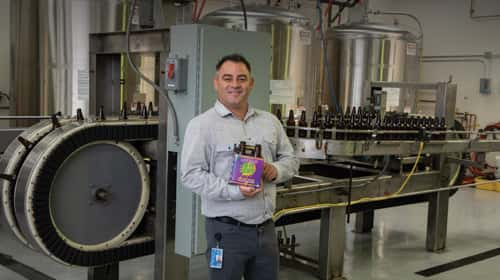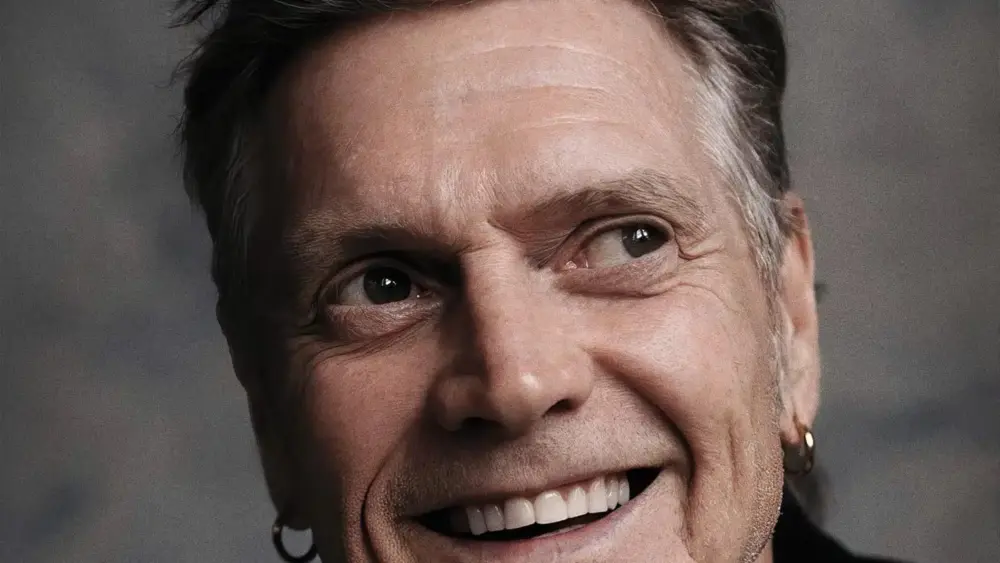Dennis Hunter was born ahead of his time, and it cost him roughly a decade of his life, either underground and on the run, or behind bars.
He co-founded CannaCraft, Inc., the highly successful Santa Rosa-based marijuana production company that makes edibles, cartridges, soft gels, sublingual drops and other products. The company employs 240 people and has its products in 500 dispensaries. CannaCraft is privately held and its brands, ABX, Care by Design and Satori Chocolates are arguably the most widely recognized in the state. Hunter doesn’t disclose an exact number, except to say that CannaCraft’s revenues “rivals and/or exceeds that of the billion-dollar, publicly-traded cannabis companies on the U.S. and Canadian exchanges.”
Hunter knows the number. He’s detail guy. And dancing around those digits probably isn’t his normal M.O, but private companies tend to be private about their cash. That said, he speaks openly with me, a reporter who he met over the phone only a few minutes before. He looks a little like actor Matt LeBlanc of Friends fame and perhaps LeBlanc will play him in the movie about Hunter’s unlikely story. In that flick, those 10 missing years will be at the heart of the tale.
To begin with, there were the seven months he spent in the Mendocino County Jail in 1992 at the age of 20, behind a guilty plea for growing weed. Next, there’s the four-and-a-half years he spent underground trying to stay one step ahead of the feds, who wanted him to be their guest for 25 or 30 years—once again for producing marijuana.
Finally, there is the six-and-half years he spent locked up in a pair of federal minimum-security prisons for violating federal drug laws.
Hunter had plenty of time to think about what he had done, why he had chosen a life of growing pot and why it was a crime. And for most of the time he was inside, he kept coming back to a simple idea. Marijuana is a good thing. It helps people and the federal government doesn’t get that.
In moments like that, Hunter felt he had been wronged.
Here’s another moment. It takes place in a cannabis dispensary, while he was on the run. He’s sitting in the dispensary and an emotionally-torn man is telling him a story.
The man’s in his late 50s and his wife is sick with cancer. “He said she was withering away—she was down to 78 pounds. He didn’t care, he said, he would try anything to help her,” Hunter recalls. “He had never used cannabis. We sat down with him and taught him how to roll a joint, sent him home with some pre-rolls. A month later he shows up with tears in his eyes, and I didn’t know what to think. Then he comes across the room and begins hugging me. She had gained eight pounds and was feeling better.”
Hunter takes a breath across the phone line. “I’ve seen that kind of thing so many times.”
The science-art-mojo of marijuana
His creating CannaCraft, along with Ned Fussell, was about tapping into the future of cannabis and combining the drug with health benefits. Make no mistake, Hunter and Fussell intended to profit from the undertaking. But their focus on extracts and the brand Care by Design are a testament to both understanding where the cannabis industry was going to go and how the drug can help people.
To oversimplify, Care By Design are a group of products that present users with five ratios of cannabidiol or CBD and Tetrahydrocannabinol, more commonly known as THC. CBD is a non-psychoactive ingredient in cannabis that aids with a number of conditions, including pain and anxiety. THC is the ingredient in pot that gets one high, but has medicinal benefits of its own. CBD and THC are most effective when used in conjunction. The Care By Design products presents users with specific ratios of CBD to THC to allow patients to personalize the experience, with the products being consistent because of how they are formulated.
But Care by Design is light years away from Hunter’s life as a teenager in Willits, Calif.
At the time, Willits, like other cities in Mendocino, Humboldt and Trinity counties, was in the midst of an outlaw movement. Marijuana was the No. 1 cash crop and a shadow economy running on cash from growers and sellers was building, even as state and federal officials did their best to control the blooming sector. Growers settled up bills at hardware stores with fistfuls of cash in the Emerald Triangle, nicknamed for the three counties that comprised the pot-growing region. The Triangle was ground zero for the marijuana trade in the United States. The rugged land was bountiful in more than its famed giant redwoods. It also raised up locals with a fierce independent spirit that distrusted all forms of government, long before anyone knew how to pronounce the words cannabis sativa.
That distrust spilled out in a number of ways. In 1984, residents in Humboldt County filed a federal lawsuit to slow down the efforts of the Campaign Against Marijuana Planting or CAMP. The action charged that CAMP was using U-2 spy planes to do high altitude searches for drugs and that the flyovers violated the privacy of the residents.
It was an unusual time to come of age, something not lost on Hunter. Logging, the primary industry in the area was on the wane in a place where timber had been king. Unemployment was up, and idle hands led to exploring what else might grow in the fertile soil in Mendocino. Hunter’s family moved from his native Arcata to Willits as he entered his teenage years.
The Backstory
His parents were entrepreneurial, exploring a number of ways to make a living. That industrious spirit was handed down to Hunter, even at an early age. He joined his family in flipping houses, learning his way around construction before he was out of high school.
And while Hunter developed those skills, he was also drawn to the woods and the hills that surrounded his community. He had friends who had parents growing cannabis, and he was impressed with how happy they were, making their way by being creative.
Hunter also discovered he had a skill for growing marijuana, so much so that he grew a little too much. He was arrested and found guilty of illegal cultivation under Mendocino regulation. He soon found himself in jail, doing 200 days of county time in Ukiah.
It was the first time his relationship with cannabis would land him behind bars, and the beginning of a path where making a living and dodging the law were one in the same. Hunter headed north to Humboldt to grow more weed.
During this time he simply grew the crop and sold it wholesale to others who actually distributed the drug. “That is what most people who grew it did. We didn’t have any of the day to day, we just grew it and sold it.”
He became expert not just at raising up a quality crop, but at also doing his best to de-risk his way of making a living. His “grows” were small at first, 20 or 30 plants, with irrigation systems set up so Hunter would only have to spend a minimum amount of time with the plants to lessen his link to the pot as well as his legal jeopardy.
While growers had to deal with law enforcement authorities who wanted to snuff out crops and make arrests, there were also those who would raid the crops looking to rip off the plants for their own gains.
Gone, gone, gone
One day in 1998, one of Hunter’s employees told him there were a small group of men walking on the property. Fearing the trespassers were looking to ripoff the grow, Hunter and others went looking for the intruders. He found them in the woods, and they told him they had a permit to cut firewood. He gave them a ride back to their car to get a look at their documents. Everything seemed to be in order, and he thought that was the end of it, but federal agents had found the property, and a raid shortly followed. When Hunter learned they had been busted by federal agents, he gathered his wife and newborn child, warned his employees and hit the ground running.
This is where Hunter’s tale takes a turn. He went underground. He left 12,500 plants behind along with his home and land. At first, he headed for Sonoma. He spoke to a lawyer who told him he was facing 25 to 30 years. “That was too much time. I couldn’t do that to my family,” he says.
He settled in Nevada City and did odd jobs. He set up grows for other people, and owned pieces of two different pot dispensaries, including one on Santa Rosa. But mostly he tried to keep his head down and provide for his family. “I was hiding in plain sight,” Hunter says. “It was a scary time, always looking back. It weighed on me.”
In 2002, his luck evaporated. Hunter was busted. “In some ways, it was almost a relief getting caught and being sentenced,” he says.
But a single act of kindness reminded him of how quickly life could change. Shortly before sentencing, Hunter was in a gas station filling up his tank when he looked over and saw a man go down pumping gas. He ran over and tried to help. He asked others if anyone knew CPR. “The guy was 85 or 90 years old. Nobody said anything, and so I just jumped in,” says Hunter. “It seemed like forever, but it was probably like five minutes. Pretty soon there are fire trucks and cops and EMTs. They took over, and then took the man to the hospital. I just wanted to kind of fade out of there.”
Once the man had recovered, he began going to the gas station looking for Hunter, wanting to thank him for his quick actions and to explain how they may have saved his life. “He wound up testifying at my sentencing. The whole place was in tears. There was also a change of prosecutors, and this one was not as anti-cannabis.”
The bottom line? The feds no longer were demanding Hunter spend 30 years in prison. He served 6.5 years in Nevada and Oregon federal minimum securities facilities before being paroled and placed on a stringent probation that restricted him from engaging in any business tied to weed.
The green rush
So, Hunter went all Mark Twain, as the green rush began. “During the gold rush it’s a good time in the pick-and-shovel business” Twain once famously observed. Hunter began a distribution business designed for the hydroponics industry that was in turn catering to those growing bud. “I was selling shovels to those who were growing. All I kept thinking was that the one thing I knew was weed, and I wasn’t allowed to grow. But I could help those who were growing. I even created a few products myself that helped.”
But as he watched from the sidelines, he sensed things were changing. While Hunter was old school and could grow weed with anybody indoors or outdoors, the new school players were slowly making inroads. “There was a sort of split between those of us who had made a living for years growing, and the people who saw the industry as someplace to make money,” he says.
So, while old school players may have smarted at the influx of new money without much knowledge of how the pot sector had gotten to that point, Hunter also saw an upside. “There are people coming into the industry who are smart, scientists, chemists. There may be new money coming in, but there’s also new talent.”
Hunter and Fussell began looking at how to safely and accurately extract oil from pot. They purchased a machine and essentially reverse engineered it, improving its operation and creating a better model for their own use. Successful and safe extraction of oil would enable the two to create products that were consistent and could compete more successfully in a market where consumers were used to brownies that ranged in dosages from delicious to destructive, in the same batch with no explanation or measurement.
The two realized their extraction process was the key to the business, along with the ability to scale, and CannaCraft was born.
CannaCraft led tours for officials of its facility, explaining how the products were made and receiving all the proper certifications. Things were going smoothly as the company began building a brand and a business amid a constantly changing industry.
But on June 15, 2016, all of that changed. Nearly 100 Santa Rosa police officers raided CannaCraft headquarters acting on a tip that the cannabis company was producing hash oil using butane for extraction. As the heavily-armed officers swarmed the plant, Hunter was taken back in time. He was handcuffed, read his rights and put in the back of a squad car, complete with pushing his head down as they put him in the back seat. “I’m thinking we had done everything by the book, we had 140 employees and we were doing business in the open. This is a legal business. Then the next minute I’m thinking oh my God, did I screw things up?”
At the police station, things weren’t any clearer for Hunter. “One of the cops said, ‘You aren’t anything but a drug pusher,’” Hunter recalls.
Later, when he and others were being advised of their bail amounts, things became even murkier. “They keep calling people up and telling them the amount of bail,” Hunter says. “They get to me and the guy stops, and he goes and talks to a couple other guys. He comes back and says ‘what did you do? He says he has never seen bail this high.”
In the wisdom of the DA’s office, Hunter needed to make a $5 million bail before he was getting out. “My heart sunk,” says Hunter.
After a sleepless night, he was released, the charges dropped and the bail eliminated. But even Hunter’s release was surreal. “Hunter, roll it up, grab your bunk,” he was told as they took him to a section of rooms on the bottom floor of the jail. “The rooms were padded and they stripped me down. But there were people who were outside protesting my arrest, seemed like they (the police) had kicked the beehive. They were worried about maybe the protesters coming inside and trying to break me out or something.”
He was released, but things had changed. The police had seized $680K in cash as well as machines that the company had used to extract cannabis oil. “They held onto everything for a while,” says Hunter. “While we were waiting for the machines to be returned to us, other people in the business stepped up and helped us out.” Local law enforcement kept CannaCraft’s equipment, inventory and office supplies for more than a year, until most of it was unusable or obsolete.
From high crime to high celebrity
Today, in the colorful world of cannabis, Dennis Hunter is a star.
He recently made the High Times list of the 100 most influential people in the cannabis industry. For years, High Times was the Bud Bible, the Joint Journal, the Bong Bulletin if you will. It’s the second year in a row Hunter received the honor.
You can find Hunter quoted in the Los Angeles Times, Forbes Magazine and Marijuana Business Magazine. He is Episode 26 of the Brave New Weed Podcast “From Outlaw to Model Citizen.” These days Hunter is high profile, or as high profile as a low-key guy gets.
He advises elected officials in Sacramento on cannabis issues. He advocates for both his industry and the drug itself. And CannaCraft is active in the community.
In short, he has become downright respectable. But in the quiet moments, when he’s alone with his thoughts and perhaps a joint, when the interior entrepreneur asks what’s next, and the old school weed grower who stacked time ponders the riddle as well, that dialogue must be fascinating.
This might come close to an answer, “The truth is that I always felt like I had been wronged, like what I was doing [growing] was justified,” says Hunter. “But I had to do it the wrong way before I found the right way.”
Author
-

Bill Meagher is a contributing editor at NorthBay biz magazine. He is also a senior editor for The Deal, a Manhattan-based digital financial news outlet where he covers alternative investment, micro and smallcap equity finance, and the intersection of cannabis and institutional investment. He also does investigative reporting. He can be reached with news tips and legal threats at bmeagher@northbaybiz.com.
View all posts




